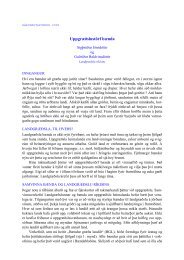Factors involved in ice nucleation and propagation ... - Landbunadur.is
Factors involved in ice nucleation and propagation ... - Landbunadur.is
Factors involved in ice nucleation and propagation ... - Landbunadur.is
You also want an ePaper? Increase the reach of your titles
YUMPU automatically turns print PDFs into web optimized ePapers that Google loves.
42 BÚVÍSINDI<br />
YFIRLIT<br />
Þættir sem hafa áhrif á myndun og dreif<strong>in</strong>gu ískr<strong>is</strong>talla í plöntum: yfirlit byggt á nýrri þekk<strong>in</strong>gu sem<br />
aflað hefur verið með <strong>in</strong>nrauðri hitamyndatöku<br />
Notkun <strong>in</strong>nrauðra hitaljósmynda hefur opnað mönnum sýn á smáatriði í frostferli í öllum þeim plöntutegundum<br />
sem prófaðar hafa verið. Þessi þekk<strong>in</strong>g bendir til möguleika á að auka varnir gegn fryst<strong>in</strong>gu.<br />
Þróun þykkari yfirhúðar eða myndun vatnsfæl<strong>in</strong>na h<strong>in</strong>drana geta stöðvað ísmyndun utan frá. Val á<br />
h<strong>in</strong>drunum fyrir dreif<strong>in</strong>gu á ís í trjákenndum plöntum sem þola undirkæl<strong>in</strong>gu blómskipana, þrátt fyrir ís<br />
í stofn<strong>in</strong>um, geta leitt til auk<strong>in</strong>s þols gegn vorfrostum. Loks hafa komið fram vísbend<strong>in</strong>gar um að frostþolspróte<strong>in</strong><br />
auki undirkæl<strong>in</strong>gu plantna. Í gre<strong>in</strong><strong>in</strong>ni er gefið yfirlit yfir fyrri niðurstöður og gre<strong>in</strong>t frá rannsóknum<br />
sem unnið er að.<br />
INTRODUCTION<br />
In order for <strong>ice</strong> to form on or with<strong>in</strong> a plant,<br />
<strong>ice</strong> <strong>nucleation</strong> must first occur. Although the<br />
melt<strong>in</strong>g po<strong>in</strong>t of <strong>ice</strong> <strong>is</strong> 0°C, the freez<strong>in</strong>g temperature<br />
of water <strong>is</strong> not as def<strong>in</strong>ed (Ashworth,<br />
1992). In fact, although it <strong>is</strong> not commonly<br />
recognized, pure water has a low probability<br />
of freez<strong>in</strong>g at temperatures warmer than –40°C<br />
(Franks, 1985). Th<strong>is</strong> <strong>is</strong> because a small <strong>ice</strong><br />
crystal embryo <strong>is</strong> necessary <strong>in</strong> order for <strong>ice</strong> to<br />
form <strong>and</strong> grow to any substantial size. The<br />
probability of form<strong>in</strong>g such an <strong>ice</strong> crystal<br />
embryo <strong>in</strong> pure water, as well as the half-life<br />
of such a crystal, <strong>is</strong> low until temperatures<br />
approach<strong>in</strong>g –40°C. Th<strong>is</strong> temperature <strong>is</strong> referred<br />
to as the homogeneous <strong>ice</strong> <strong>nucleation</strong><br />
po<strong>in</strong>t.<br />
In nature, it <strong>is</strong> rare for water to ex<strong>is</strong>t <strong>in</strong> a<br />
pure state but it rather ex<strong>is</strong>ts as an ionic or<br />
colloidal solution. In such solutions heterogeneous<br />
<strong>ice</strong> <strong>nucleation</strong> <strong>is</strong> <strong>in</strong>itiated on the surface<br />
of objects or on suspended particles (Ashworth,<br />
1992). Heterogeneous <strong>ice</strong> nucleators<br />
are very effective <strong>in</strong> <strong>in</strong>duc<strong>in</strong>g <strong>ice</strong> formation<br />
<strong>and</strong> are very abundant. As a consequence, freez<strong>in</strong>g<br />
occurs <strong>in</strong> nature at much warmer temperatures<br />
than the homogeneous <strong>nucleation</strong><br />
temperature.<br />
The role of heterogeneous <strong>ice</strong> nucleators<br />
<strong>in</strong> <strong>in</strong>duc<strong>in</strong>g <strong>ice</strong> formation <strong>in</strong> plants <strong>is</strong> important<br />
because if methods can be developed for<br />
regulat<strong>in</strong>g <strong>ice</strong> <strong>nucleation</strong>, significant advances<br />
could be made <strong>in</strong> limit<strong>in</strong>g frost <strong>in</strong>jury to both<br />
freez<strong>in</strong>g-sensitive <strong>and</strong> cold adapted plants. A<br />
major question concerns the relative importance<br />
of extr<strong>in</strong>sic <strong>ice</strong> <strong>nucleation</strong> agents, such<br />
as <strong>ice</strong>-<strong>nucleation</strong>-active (INA) bacteria (e.g.<br />
Pseudomonas syr<strong>in</strong>gae), <strong>and</strong> <strong>in</strong>tr<strong>in</strong>sic <strong>nucleation</strong><br />
agents synthesized by plants (Ashworth<br />
<strong>and</strong> Kieft, 1995). While all plants can supercool<br />
(i.e., have t<strong>is</strong>sues below 0°C without freez<strong>in</strong>g)<br />
to some extent (Ashworth <strong>and</strong> Kieft, 1995;<br />
Burke et al., 1976; L<strong>in</strong>dow, 1995; L<strong>in</strong>dow et<br />
al., 1978), the extent of supercool<strong>in</strong>g varies<br />
between plant species <strong>and</strong> <strong>is</strong> <strong>in</strong>fluenced by the<br />
presence of <strong>ice</strong> nucleat<strong>in</strong>g agents which may<br />
be of plant (L<strong>in</strong>dow et al., 1978; Fuller et al.,<br />
1994; Andrews et al., 1984; Gross et al., 1988)<br />
or bacterial (Gross et al., 1984; Hirano et al.,<br />
1985; L<strong>in</strong>dow, 1983) orig<strong>in</strong>.<br />
The abundance of <strong>ice</strong> nuclei on plants can<br />
be estimated by freez<strong>in</strong>g of droplets of plant<br />
macerates or small portions of plant t<strong>is</strong>sue<br />
(Ashworth <strong>and</strong> Kieft, 1995; L<strong>in</strong>dow, 1983)<br />
but these procedures are destructive <strong>and</strong> do<br />
not provide <strong>in</strong>formation on where <strong>ice</strong> formation<br />
was <strong>in</strong>itiated. Ice formation <strong>in</strong> <strong>in</strong>tact plants<br />
can be readily detected by measur<strong>in</strong>g, with<br />
thermocouples, the heat that <strong>is</strong> released upon<br />
the freez<strong>in</strong>g of the water <strong>in</strong> the plant (Ashworth,<br />
1992; Cary <strong>and</strong> Mayl<strong>and</strong>, 1970; Proebst<strong>in</strong>g et<br />
al., 1982; Quamme et al., 1972). Nevertheless,<br />
even when arrays of temperature measur<strong>in</strong>g<br />
dev<strong>ice</strong>s are attached to plants, however,<br />
the actual site of <strong>ice</strong> <strong>in</strong>itiation <strong>and</strong> the temperature<br />
at the site where <strong>ice</strong> <strong>nucleation</strong> occurred<br />
can only be <strong>in</strong>ferred (Ashworth et al.,<br />
1985). Th<strong>is</strong> <strong>is</strong> a significant technical limitation<br />
<strong>and</strong> more details of the freez<strong>in</strong>g process<br />
are required <strong>in</strong> order to accurately predict freez<strong>in</strong>g<br />
patterns <strong>and</strong> determ<strong>in</strong>e under what condi-
















